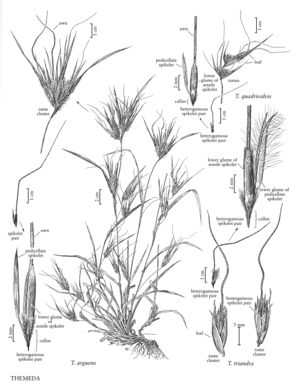Difference between revisions of "Themeda quadrivalvis"
imported>Volume Importer |
imported>Volume Importer |
||
| Line 46: | Line 46: | ||
|publication year= | |publication year= | ||
|special status=Introduced | |special status=Introduced | ||
| − | |source xml=https:// | + | |source xml=https://bitbucket.org/aafc-mbb/fna-data-curation/src/2e0870ddd59836b60bcf96646a41e87ea5a5943a/coarse_grained_fna_xml/V25/V25_1635.xml |
|subfamily=Poaceae subfam. Panicoideae | |subfamily=Poaceae subfam. Panicoideae | ||
|tribe=Poaceae tribe Andropogoneae | |tribe=Poaceae tribe Andropogoneae | ||
Revision as of 22:03, 5 November 2020
Plants annual. Culms to 2 m, glabrous. Sheaths glabrous, flattened at the base; ligules 1-2.5 mm; blades to 60 cm long, 1-6 mm wide, usually folded. False panicles to 130 cm; sheaths subtending the rame clusters 17-50 mm, distal sheaths shorter and more strongly keeled, margins tuberculate; rames 1-3 per cluster, 8-10 mm, with 1-2 heterogamous spikelet pairs. Homogamous spikelets 4-7 mm; lower glumes many-veined, hairy distally, hairs papillose-based; upper glumes subequal to the lower glumes, 3-veined. Sessile heterogamous spikelets 4-6 mm; calluses 0.5-3 mm; lower glumes glabrous or sparsely hirsute; upper glumes 4.5-5.5 mm; awns 4-5 cm; pedicellate spikelets 4.5-5.5 mm, sterile. 2n = 18.
Distribution
Kans., Fla., Calif., La.
Discussion
A native of Malaysia, Themeda quadrivalvis has been found at scattered locations in the contiguous United States. Towne and Ballard (2002) reported that it is a common contaminant of the thistle seed sold for bird feeders. Most of the seeds are sterile, but a few are not. It is established in St. Landry and Iberia parishes, Louisiana, in addition to having escaped from cultivation in Florida (Baird and Thieret 1985)
